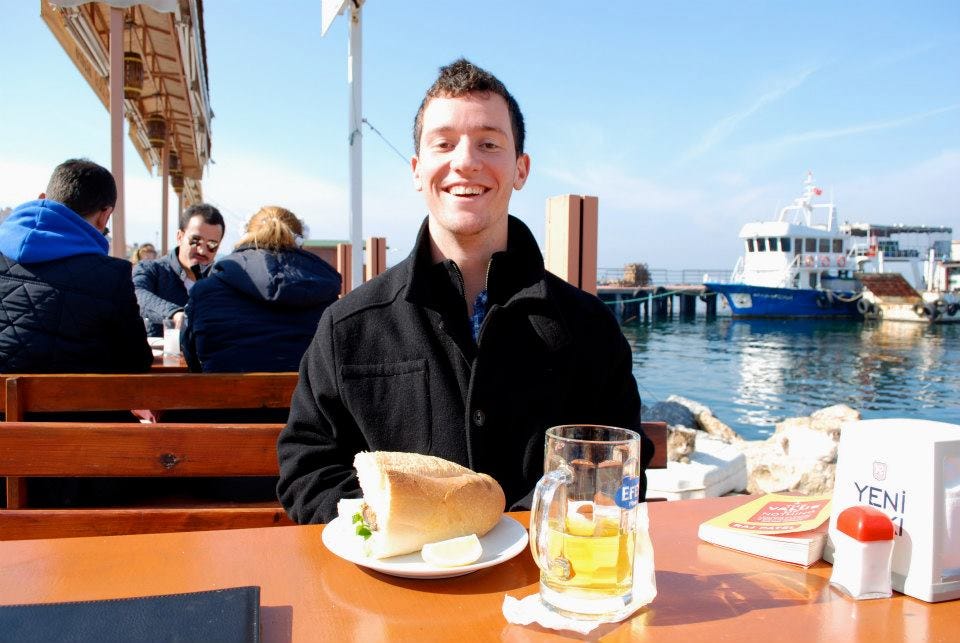The Tailor in the Grand Bazaar
What Substack is getting right
In college I studied for a semester in Istanbul. My first week there, I tore a hole in the breast of my winter jacket1. Our professor kindly took me to a tailor on a side street in Ortaköy, the quiet neighborhood where we were staying. He showed my ripped peacoat to the tailor, a Turkish man in his early 70s, and they exchanged a few words that I couldn’t understand.
A few days later we returned, and the tailor had expertly stitched a fake pocket which entirely covered up the hole. I was so relieved — the coat was brand new, and my only warm attire — and I clumsily pulled out a wad of Lira, eager to pay for the bit of magic the tailor had performed.
My professor went back and forth with him for a moment, and then turned to me: “he says, ‘what can I charge for this? It was just a scrap of fabric.’”
The tailor didn’t want any money.
I was blown away, and tried to convey my gratitude, fumbling over the “thank you” I’d learned a few days before.

The next week, we visited the Grand Bazaar, the sprawling market in Istanbul’s historic peninsula. It is a maximally frenetic place, with hundreds of vendors selling all sorts of things, from televisions to backgammon sets to menswear. It is a fun place to wander around, if you have the energy to politely resist the persistent salespeople and are not in a rush.
Being a tailor in the Grand Bazaar would be an entirely different proposition than owning a shop like my pro bono tailor’s in Ortaköy. Ortaköy is a lovely neighborhood where you can take pride in designing the whole experience you deliver to your customers. But it’s a quiet place: to flourish, you’d either need to spend years building up a reputation, or be a good marketer as well as a good tailor.
For an ambitious young tailor who doesn’t have a reputation, it might be better to go to where the customers are: to rent a spot in the Grand Bazaar and sell to the flock of people who are already there, looking to buy things. This means you sacrifice some control and some economics to the group that runs the bazaar. But in return you get a ton of potential customers piped through narrow corridors straight to your shop.
There is a similar choice facing writers who are choosing where to publish their work on the internet, and right now Substack — the Grand Bazaar — seems like it is winning.
Slowly, and then all at once
, who I had previously followed on Twitter and writes really well about our relationship to work, wrote this about Substack notes in February. It feels spot on to me:Google search interest in Substack inflected around the US election in November ‘24 and it feels like the platform has developed enough of gravitational pull that it will continue to attract writers who otherwise might have stayed independent:
I recently saw that The New Consumer, a publication which puts out interesting analysis of consumer trends, is beginning to distribute to Substack in addition to its own website. This passage in Feed Me articulates his decision to do both:
The biggest question I hear people have when starting a newsletter business has been: Substack or another platform?
decided that there doesn’t need to be an or — he’s going to begin publishing his six-year-old newsletter, The New Consumer, on multiple platforms. His first letter on Substack reads, “…Substack has crossed into the everyday lexicon, at least among my target readers. And it has figured out some network effects, which are rare in the media business.”
This makes sense to me, and I expect lots of other publications are making similar moves as Substack’s consumer / creator flywheel speeds up. For years I wrote semi-regularly on a website that I own, lots of articles like this one. Substack has been much more fun.
Some back of the envelope math from my website: Over the years, ~50k views led to 130 email subscribers, or a 0.4% subscription rate. In a year and a half on Substack, ~80k views have led to 885 email subscribers, or a 1.1% subscription rate. So it’s been easier to get people to read what I write, and easier to build a direct connection to them through email.
Of course, this is not the first time a platform has aggregated a bunch of consumer demand. But Substack feels relatively sustainable, mainly because it lets the creator retain a direct relationship to the user through their email address. This lets creators trust that they can take advantage of the growth the platform offers without being completely beholden to it.

What is Substack Doing Right?
Maintaining the creator’s direct connection to the audience is the foundation, and Substack’s been able to build a vibrant ecosystem on top of that. These are their tactics that feel most important to me.
It lets you outsource the cringe: The platform does the work that I find aesthetically displeasing. It nudges people to subscribe, it reminds people when I post something. It’s pushy. I find this to be somewhat cringey, but if the platform is doing it I am happy to benefit from it.
Removing the friction from email signup flows drastically increases the number of signups. It’s very easy to subscribe to a newsletter on Substack, which means a higher conversion rate than on an independent website. If you are logged into the app it’s a single button to subscribe, and no need to confirm your email address like you would from most independent newsletters.
Notes is really good, actually! It has largely taken the place of Twitter for people promoting their work, and it is better at it than Twitter was because the longform work is native to the platform, so people are more inclined to consume it.
The Notes algorithm does not weight recency as highly as most social feeds. It is not trying to be the place to find out what is happening right now. This leads to a calmer & more rewarding experience for the writer, because it feels like the things you write hold their value for much longer. I like this characterization:
It also means higher quality, less sensational content for the reader than a feed like Twitter’s which is meant to surface what is going on Right Now.
Creators are nice to each other. I think that because Substack began as a creator-focused platform (as opposed to more traditional social media which is consumer-focused from the beginning), its culture is driven by people who create longform content, and they tend to be kinder and more constructive to other creators than the median user on Twitter who does not have immediate empathy for other people creating things.
The algorithm is cozy: The feed stays tight enough that I feel like I “run into” the same people regularly. This sense of familiarity gives it a much cozier feeling than twitter which felt more anonymous. I expect this is an algorithmic decision as well as a function of the platform still being fairly small.
They’re keeping the Main Thing the Main Thing: I thought this article by Substack’s head of design was excellent. It describes a culture which has a strong guiding force, leading them to make different decisions than a management team that is guided by something more common like “what will keep us from being embarrassed”:
What matters on Substack is whether creatives make money. Everything else —polish, beauty, coherence, even in some cases usability— is subservient to whether Design is helping creatives make money.
. Emphasise mine.
Of course, this means there are parts of the product that are not very coherent or useful. But that is okay! I would so much rather they spend their time balancing the Notes algorithm and coming up with new growth features than polishing parts of the product that don’t directly help creatives make money.
This is why I was amused rather than upset about a recent update to their analytics product. I still think it is a sort of ridiculous decision, but optimizing the analytics product doesn’t matter that much for helping creators grow, so I appreciate that it is not very good. They are prioritizing the things that matter most for creators making money — finding them new audience and helping them convert people to paid subscribers. It is also a very good sign that 8 years in, one of the cofounders is in the product replying to my2 critiques.
Of course there are risks to all of this growth, and it won’t stay cozy forever. As the friction to subscribing to newsletters goes down, people will subscribe to more of them and engage less deeply with each one. The notes app will attract more celebrities, brands, and mean-spirited people. AI-generated content will proliferate.
If you go to the Grand Bazaar now, it’s overrun by tourists, and I have to imagine is a shadow of what it once was. But for now, I’m enjoying this time on Substack, where a platform has managed to get the big things right.

Tangentially but much more importantly, I found this video of a Turkish PhD student at Tufts being arrested by plainclothes ICE agents to be particularly chilling. She was then flown, without being charged with a crime, to a detention center in Louisiana.
Supposedly she was targeted because she coauthored an op-ed encouraging Tufts to divest from companies doing business with the Israeli government. Marco Rubio defended ICE’s actions: “We gave you a visa to come and study and get a degree, not to become a social activist, to tear up our university campuses… once you've lost your visa, you're no longer legally in the United States, and we have a right, like every country in the world has a right, to remove you from our country.”
Regardless of the reasons she was detained, I encourage you to watch the video and ask yourself: is this what we want America to be?
Please consider donating to the Massachusetts ACLU or the Center for Constitutional Rights who are helping provide legal aid to people in terrifying situations like this one.
On a lighter note,
’s interview with Eugene Wei was an excellent overview of what is going on with technology in our society. Wei is brilliant — his article about being a young employee at Amazon in the late 90s, fighting with the printer to make sure Bezos saw the right charts, is one of my favorites. He also comes across as a kind person who reasons in good faith and wants what is best for humanity.Have a good weekend!
I really mean I tore a hole in it. We had bought a bottle of wine and were sitting on the edge of the Bosphorus, enjoying the beautiful view over the water, and realized we did not have a corkscrew. My friend Stephen and I had learned that if you bang the bottom of a wine bottle repeatedly on a hard surface, the pressure will force out the cork. So we did that, banging the bottle on a tree, with my coat wrapped around the base of the bottle so that it wouldn’t crack. The bottle opened, and I felt like a hero for about 30 seconds, before realizing that my peacoat wasn’t meant to withstand being smashed against a glass bottle.
I am, famously, Just Some Guy



Cozy vibes are being enjoyed!